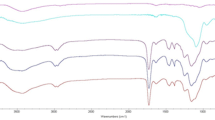Abstract
The authors describe a nanomaterial for solid-phase extraction of carbendazim. Magnetic molecularly imprinted polymer nanoparticles (mag-MIP-NPs) were obtained by immobilizing the MIP and a thiolated β-cyclodextrin on the surface of magnetite (Fe3O4) nanoparticles coated with gold nanoparticles. Both the recognition sites of the MIP and the hydrophobic cavities in the β-cyclodextrin contribute to the specific molecular recognition and extraction of carbendazim. The mag-MIP-NPs have an apparent adsorption capacity of 190 mg⋅g‾1. Spiked vegetables were analyzed by using this material for extraction of carbendazim prior to its determination by ultra performance liquid chromatography (UHPLC). Recoveries range from 90.5 % to 109 %, and the detection limit is 3.0 pg⋅mL‾1.

Magnetic molecularly imprinted polymer nanoparticles (mag-MIP-NPs) were synthesized based on a thiolated β-cyclodextrin on the magnetic nanocomposite. Due to the synergetic dual recognition and separation effect, mag-MIP-NPs showed the good adsorption capacity of 190 mg⋅g‾1 for carbendazim.






Similar content being viewed by others
References
Van den Brink PJ, Hattink J, Bransen F, Van Donk E, Brock T (2000) Impact of the fungicide carbendazim in freshwater microcosms. II. Zooplankton, primary producers and final conclusions. Aquat Toxicol 48:251–264
Palanikumar L, Kumaraguru AK, Ramakritinan CM, Anand M (2014) Toxicity, biochemical and clastogenic response of chlorpyrifos and carbendazim in milkfish Chanos chanos. Int J Environ Sci Te 11:765–774
Lin L, Peng Z, Yang CL, Wang MY, Zha YB, Liu LL, Zeng SD (2013) Determination of imidacloprid, carbendazim and thiabendazole residues in vegetables and fruits by HPLC. Adv Mater Res 781:1392–1396
Haupt K, Mosbach K (2000) Molecularly imprinted polymers and their use in biomimetic sensors. Chem Rev 100:2495–2504
Bates F, del Valle M (2015) Voltammetric sensor for theophylline using sol–gel immobilized molecularly imprinted polymer particles. Microchim Acta 182:933–942
Gao L, Chen L, Li X (2015) Magnetic molecularly imprinted polymers based on carbon nanotubes for extraction of carbamates. Microchim Acta 182:781–787
Pardeshi S, Dhodapkar R, Kumar A (2014) Molecularly imprinted microspheres and nanoparticles prepared using precipitation polymerisation method for selective extraction of gallic acid from Emblica officinalis. Food Chem 146:385–393
Li Y, Zhao X, Li P, Huang Y, Wang J, Zhang J (2015) Highly sensitive Fe3O4 nanobeads/graphene-based molecularly imprinted electrochemical sensor for 17β-estradiol in water. Anal Chim Acta 884:106–113
Zhou J, Gan N, Li T, Hu F, Li X, Wang L, Zheng L (2014) A cost-effective sandwich electrochemiluminescence immunosensor for ultrasensitive detection of HIV-1 antibody using magnetic molecularly imprinted polymers as capture probes. Biosens Bioelectron 54:199–206
Li L, Fan L, Dai Y, Kan X (2015) Recognition and determination of bovine hemoglobin using a gold electrode modified with gold nanoparticles and molecularly imprinted self-polymerized dopamine. Microchim Acta 182:1–7
Kecili R, Billing J, Nivhede D, Sellergren B, Rees A, Yilmaz E (2014) Fast identification of selective resins for removal of genotoxic aminopyridine impurities via screening of molecularly imprinted polymer libraries. J Chromatogr A 1339:65–72
Zhao M, Zhang C, Zhang Y, Guo XZ, Yan HS, Zhang HQ (2014) Efficient synthesis of narrowly dispersed hydrophilic and magnetic molecularly imprinted polymer microspheres with excellent molecular recognition ability in a real biological sample. Chem Commun 100:2208–2210
Gu L, Jiang X, Liang Y, Zhou T, Shi G (2013) Double recognition of dopamine based on a boronic acid functionalized poly(aniline-co-anthranilic acid)-molecularly imprinted polymer composite. Analyst 138:5461–5469
Andersson HS, Karlsson JG, Piletsky SA, Koch-Schmidt AC, Mosbach K, Nicholls IA (1999) Study of the nature of recognition in molecularly imprinted polymers, II: influence of monomer-template ratio and sample load on retention and selectivity. J Chromatogr A 848:39–49
Zhong N, Byun HS, Bittman R (2001) Hydrophilic cholesterol-binding molecular imprinted polymers. Tetrahedron Lett 42:1839–1841
Sajomsang W, Nuchuchua O, Gonil P, Saesoo S, Sramala I, Soottitantawat A, Puttipipatkhachorn S, Ruktanonchai UR (2012) Water-soluble β-cyclodextrin grafted with chitosan and its inclusion complex as a mucoadhesive eugenol carrier. Carbohydr Polym 89:623–631
Srinivasan K, Stalin T, Shanmugapriya A, Sivakumar K (2012) Spectroscopic and electrochemical studies on the interaction of an inclusion complex of β-cyclodextrin with 2, 6-dinitrophenol in aqueous and solid phases. J Mol Struct 1036:494–504
Kyzas GZ, Lazaridis NK, Bikiaris DN (2012) Optimization of chitosan and β-cyclodextrin molecularly imprinted polymer synthesis for dye adsorption. Carbohydr Polym 91:198–208
Zhang W, Qin L, He XW, Li WY, Zhang YK (2009) Novel surface modified molecularly imprinted polymer using acryloyl-β-cyclodextrin and acrylamide as monomers for selective recognition of lysozyme in aqueous solution. J Chromatogr A 1216:4560–4567
Kang YS, Risbud S, Rabolt JF, Stroeve P (1996) Synthesis and characterization of nanometer- size Fe3O4 and γ-Fe2O3 particles. Chem Mater 8:2209–2211
Lee J, Kwon SG, Park JG, Hyeon T (2015) Size dependence of metal-insulator transition in stoichiometric Fe3O4 nanocrystals. Nano Lett 15:4337–4342
Azodi-Deilami S, Najafabadi AH, Asadi E, Abdouss M, Kordestani D (2014) Magnetic molecularly imprinted polymer nanoparticles for the solid-phase extraction of paracetamol from plasma samples, followed its determination by HPLC. Microchim Acta 181:1823–1832
Li C, Wei R, Xu Y, Sun A, Wei L (2014) Synthesis of hexagonal and triangular Fe3O4 nanosheets via seed-mediated solvothermal growth. Nano Res 7:536–543
Xu Z, Hou Y, Sun S (2007) Magnetic core/shell Fe3O4/Au and Fe3O4/Au/Ag nanoparticles with tunable plasmonic properties. J Am Chem Soc 129:8698–8699
Li JP, Wei XP, Yuan YH (2009) Synthesis of magnetic nanoparticles composed by Prussian blue and glucose oxidase for preparing highly sensitive and selective glucose biosensor. Sensors Actuators B Chem 139:400–406
Bao J, Chen W, Liu TT, Zhu YL, Jin PY, Wang LY, Liu JF, Wei YG, Li YD (2007) Bifunctional Au-Fe3O4 nanoparticles for protein separation. ACS Nano 1:293–298
Acknowledgments
Project supported by the Natural Science Foundation of Hainan Province of China (No. 20152024) and the Fundamental Scientific Research Funds for Chinese Academy of Tropical Agricultural Sciences (No. 1630042015009).
Author information
Authors and Affiliations
Corresponding author
Ethics declarations
The author(s) declare that they have no competing interests
Electronic supplementary material
ESM 1
(DOC 1.12 mb)
Rights and permissions
About this article
Cite this article
Li, S., Wu, X., Zhang, Q. et al. Synergetic dual recognition and separation of the fungicide carbendazim by using magnetic nanoparticles carrying a molecularly imprinted polymer and immobilized β-cyclodextrin. Microchim Acta 183, 1433–1439 (2016). https://doi.org/10.1007/s00604-016-1765-z
Received:
Accepted:
Published:
Issue Date:
DOI: https://doi.org/10.1007/s00604-016-1765-z




